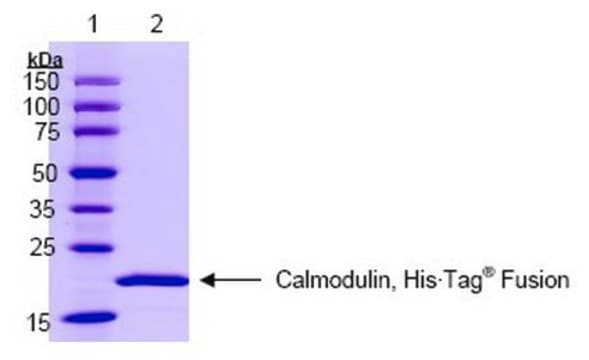208735
Calmodulin Inhibitory Peptide
The Calmodulin Inhibitory Peptide controls the biological activity of Calmodulin. This small molecule/inhibitor is primarily used for Cell Signaling applications.
Sinónimos:
Calmodulin Inhibitory Peptide, MLCK Peptide, MLCKP
Iniciar sesiónpara Ver la Fijación de precios por contrato y de la organización
About This Item
Fórmula empírica (notación de Hill):
C91H156N36O20
Peso molecular:
2074.44
UNSPSC Code:
12352202
NACRES:
NA.77
Productos recomendados
Quality Level
assay
≥95% (HPLC)
form
lyophilized
manufacturer/tradename
Calbiochem®
storage condition
OK to freeze
desiccated (hygroscopic)
solubility
water: 50 mg/mL
shipped in
ambient
storage temp.
−20°C
General description
A 17-residue peptide based on the calmodulin-binding domain of myosin light chain kinase (MLCK). Binds to calmodulin with high affinity (Kd = 6 pM).
A 17-residue peptide based on the calmodulin-binding domain of myosin light chain kinase (MLCK). Binds to calmodulin with high affinity (Kd = 6 pM). Inhibits calmodulin activation of MLCK-catalyzed phosphorylation of smooth muscle regulatory light chain(MLC).
Biochem/physiol Actions
Cell permeable: no
Kd = 6 pM in binding to calmodulin
Primary Target
Calmodulin
Calmodulin
Product does not compete with ATP.
Reversible: no
Warning
Toxicity: Standard Handling (A)
Sequence
Ac-Arg-Arg-Lys-Trp-Gln-Lys-Thr-Gly-His-Ala-Val-Arg-Ala-Ile-Gly-Arg-Leu-NH₂
Physical form
Supplied as a trifluoroacetate salt.
Reconstitution
Following reconstitution, aliquot and freeze (-20°C). Stock solutions are stable for up to 3 months at -20°C.
Other Notes
Torok,K., et al. 1998. Biochemistry 37, 6188.
Török, K., and Trentham, D.R. 1994. Biochemistry33, 12807.
Török, K., and Trentham, D.R. 1994. Biochemistry33, 12807.
Legal Information
CALBIOCHEM is a registered trademark of Merck KGaA, Darmstadt, Germany
Storage Class
11 - Combustible Solids
wgk_germany
WGK 1
flash_point_f
Not applicable
flash_point_c
Not applicable
Certificados de análisis (COA)
Busque Certificados de análisis (COA) introduciendo el número de lote del producto. Los números de lote se encuentran en la etiqueta del producto después de las palabras «Lot» o «Batch»
¿Ya tiene este producto?
Encuentre la documentación para los productos que ha comprado recientemente en la Biblioteca de documentos.
Nuestro equipo de científicos tiene experiencia en todas las áreas de investigación: Ciencias de la vida, Ciencia de los materiales, Síntesis química, Cromatografía, Analítica y muchas otras.
Póngase en contacto con el Servicio técnico








